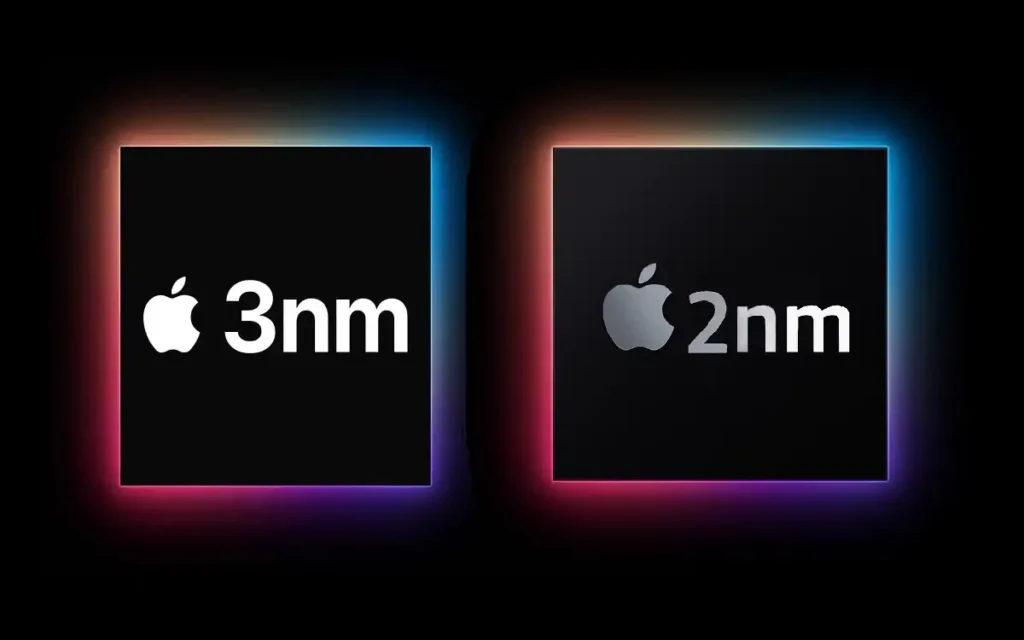As we look ahead to the future iterations of this iconic device, exciting developments in iPhone Chip Tech promise to revolutionize the user experience. The upcoming advancements in iPhone chip tech, specifically focusing on the transition from 3nm to 2nm chips and what this means for consumers.
Recent Released: How to Get MyFitnessPal Premium IPA
Introduction
The heart of every iPhone lies in its powerful chip, driving everything from basic functions to complex computations. As Apple prepares to launch its next generations of iPhones, the spotlight is on the semiconductor iPhone Chip Tech that will power these devices. The upcoming iPhone 15 and iPhone 16 series are set to showcase significant leaps in chip manufacturing, with the introduction of 3nm and 2nm technologies respectively. These advancements promise enhanced performance, improved energy efficiency, and new capabilities that will shape the future of mobile computing.
The Current Landscape: 3nm Chip Technology

What is 3nm Chip Tech?
Before we dive into the future, it’s essential to understand the present state of iPhone chip tech. The current generation of iPhones utilizes 3nm chip technology, which represents a significant improvement over its predecessors. But what exactly does 3nm mean, and why is it important?
The term “3nm” refers to the size of the transistors on the chip. As a general rule, the smaller the transistor size, the more transistors can be packed onto a single chip, leading to improved performance and energy efficiency. The 3nm process allows for an incredibly high density of transistors, resulting in powerful and efficient processors.
Benefits of 3nm Chip Tech
The adoption of 3nm Chip technology in iPhones has brought several notable benefits:
- Increased Performance: With more transistors packed into the same space, 3nm chips can process information faster and more efficiently.
- Improved Energy Efficiency: Smaller transistors require less power to operate, leading to better battery life in devices using 3nm chips.
- Enhanced Thermal Management: The improved efficiency of 3nm chips results in less heat generation, allowing for better sustained performance.
- Compact Design: The smaller chip size enables manufacturers to create slimmer devices or allocate more space for other components, such as larger batteries.
iPhone 15 and 3nm Chip Technology
Looking ahead to the iPhone 15, Apple plans to continue using 3nm chip technology, specifically TSMC’s N3P process. This decision reflects a strategic approach to balance performance improvements with cost considerations. By utilizing an enhanced version of the 3nm process across all iPhone 15 models, Apple ensures consistency in performance while optimizing production costs.
The use of TSMC’s N3P process in the iPhone 15 is expected to bring further refinements to the already impressive capabilities of 3nm technology. Users can anticipate improvements in processing speed, graphics performance, and energy efficiency compared to previous iPhone generations.
The Next Frontier: 2nm Chip Technology
What is 2nm Chip Tech
As exciting as the 3nm chips are, the tech world is already buzzing about the next big leap: 2nm chip technology. Set to debut in the iPhone 16 Pro models, 2nm chips represent the cutting edge of semiconductor manufacturing.
Advantages of 2nm Over 3nm
The transition from 3nm to 2nm technology brings several significant advantages:
- Higher Transistor Density: 2nm chips can pack even more transistors into the same area, potentially leading to substantial performance gains.
- Further Improved Energy Efficiency: The smaller transistors in 2nm chips consume even less power, promising extended battery life for devices.
- Advanced Transistor Designs: 2nm technology may incorporate new transistor architectures, such as Gate-All-Around Field-Effect Transistors (GAA FETs), offering better performance and efficiency.
- Enhanced Integration Capabilities: The 2nm process allows for more advanced integration of components, potentially leading to new features and capabilities in smartphones.
Performance Comparison: 2nm vs. 3nm
To better understand the potential impact of 2nm technology, let’s compare it to the current 3nm chips:
| Aspect | 3nm Technology | 2nm Technology | Improvement |
| Transistor Density | High | Very High | ~20-30% increase |
| Power Efficiency | Good | Excellent | ~25-35% reduction in power consumption |
| Performance | Fast | Faster | ~10-15% increase at same power level |
| Heat Generation | Low | Very Low | Further reduction in thermal output |
| Manufacturing Complexity | Complex | Very Complex | Increased production challenges |
While these figures are estimates based on industry projections, they highlight the significant advancements that 2nm technology is expected to bring.
Apple’s Strategy: A Tale of Two Chips
iPhone 15: Consistency with 3nm
Apple’s decision to use 3nm chips across all iPhone 15 models in 2025 is a strategic move that balances performance and cost. By utilizing TSMC’s enhanced N3P 3-nanometer process, Apple ensures that all iPhone 15 users will benefit from improved performance and efficiency compared to previous generations.
This approach also allows Apple to optimize production costs while maintaining consistency across the iPhone 15 lineup. Users can expect significant improvements over the iPhone 16, which introduced the second-generation 3nm A18 chip.
iPhone 16: A Split Approach
For the iPhone 16 series, expected in 2026, Apple is taking a more nuanced approach. The company plans to introduce 2nm chips, but only in the Pro models. This decision is driven by several factors:
- Cost Considerations: The production of 2nm chips involves higher manufacturing costs and potential yield issues. By limiting 2nm chips to Pro models, Apple can manage these costs more effectively.
- Market Differentiation: Using 2nm technology exclusively in Pro models creates a clear distinction between standard and premium iPhones, potentially driving more consumers towards higher-end devices.
- Performance Tiers: This strategy allows Apple to offer different performance tiers, catering to various user needs and budgets.
- Manufacturing Realities: The challenges associated with producing 2nm chips at scale may limit initial availability, making it practical to reserve them for premium models.
Impact on User Experience
Battery Life Improvements
One of the most tangible benefits users can expect from the adoption of 2nm technology in the iPhone 16 Pro models is improved battery life. The increased power efficiency of 2nm chips means that devices can perform the same tasks using less energy, potentially extending battery life significantly.
Moreover, the enhanced thermal management properties of 2nm chips contribute to overall system efficiency. Lower heat generation means the device can maintain optimal performance for longer periods without throttling, indirectly contributing to better battery life and long-term battery health.
Performance Enhancements
Users of iPhone 16 Pro models with 2nm chips can anticipate noticeable performance improvements across various applications:
- Faster Processing: The increased transistor density allows for more rapid data processing, resulting in snappier app launches and smoother multitasking.
- Enhanced AI and Machine Learning: The additional processing power can significantly boost on-device AI and machine learning capabilities, enabling more advanced features and improved real-time processing.
- Improved Graphics Performance: Gaming and graphically intensive applications will benefit from the increased computational power, potentially allowing for more console-quality gaming experiences on mobile devices.
- Efficient Background Processes: The improved efficiency of 2nm chips means that background tasks can be handled more effectively, leading to a more responsive overall user experience.
Potential New Features
The advent of 2nm technology opens the door to potential new features that may not have been possible or practical with previous chip generations. While specific features will depend on Apple’s design decisions, some possibilities include:
- Advanced AR/VR Capabilities: The increased processing power could enable more immersive and responsive augmented and virtual reality experiences.
- Enhanced Camera Processing: Improved on-device image and video processing could lead to even better computational photography features.
- More Sophisticated Voice Assistants: The additional processing power could allow for more advanced on-device natural language processing, making voice assistants more capable and responsive.
- Improved Security Features: Enhanced processing capabilities could enable more sophisticated on-device security measures, such as advanced biometrics or real-time encryption.
Challenges and Considerations
Manufacturing Complexity
The transition to 2nm technology presents significant challenges for manufacturers:
- Yield Rates: As chip sizes decrease, achieving high yield rates becomes more difficult. This can lead to higher costs per usable chip and potential supply constraints.
- Equipment Investment: Producing 2nm chips requires substantial investments in new manufacturing equipment and processes.
- Quality Control: Ensuring consistent quality at such small scales is a complex task that requires advanced testing and quality control measures.
Cost Implications
The advanced nature of 2nm technology comes with increased production costs:
- Higher Manufacturing Expenses: The complex processes and equipment required for 2nm chip production result in higher overall manufacturing costs.
- Potential Price Increases: These increased costs may be reflected in higher prices for devices featuring 2nm chips, particularly the iPhone 16 Pro models.
- Market Segmentation: The cost difference between 3nm and 2nm chips may lead to a wider price gap between standard and Pro iPhone models.
Market Positioning
Apple’s decision to use 2nm chips exclusively in Pro models has implications for its market strategy:
- Premium Differentiation: This approach clearly positions the Pro models as cutting-edge devices, potentially driving more consumers towards higher-end options.
- Consumer Expectations: Users of standard iPhone models may feel left behind, potentially creating pressure for Apple to bring 2nm technology to all models in future generations.
- Competition: Apple’s selective use of 2nm technology may influence how competitors position their devices in the market.
Finally
The transition from 3nm Chip Tech to 2nm Chip Tech represents a significant leap forward in the evolution of iPhone performance and capabilities. As Apple prepares to introduce 3nm chips across its iPhone 15 lineup and 2nm chips in the iPhone 16 Pro models, users can look forward to devices that are faster, more efficient, and capable of new and exciting features.
While the adoption of 2nm iPhone Chip Tech brings challenges in terms of manufacturing complexity and cost, it also opens up new possibilities for mobile computing. The improved performance, enhanced energy efficiency, and potential for new features make the future of iPhone Chip Tech extremely promising.
As we look ahead to the iPhone 15 and iPhone 16 series, it’s clear that Apple’s strategic approach to iPhone Chip Tech will continue to push the boundaries of what’s possible in a smartphone. Whether you’re a tech enthusiast excited about the latest advancements or a casual user looking for a device that simply works better, the future of iPhone chip tech holds something exciting for everyone.
The journey from 3nm to 2nm is more than just a reduction in transistor size; it’s a leap towards a future where our mobile devices are even more integral and capable parts of our daily lives. As Apple continues to innovate in this space, we can expect each new generation of iPhones to bring us closer to the cutting edge of what’s possible in mobile technology.






